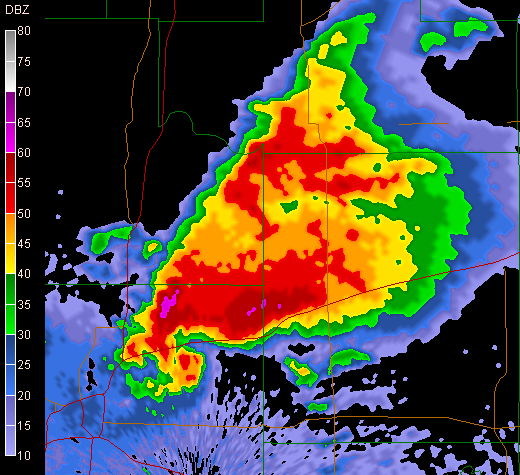
GRS applications support user-defined color tables for all graphical products. The files are simple
text files containing single line statements. All color table files use the same
syntax:
|
; ; ; Fields enclosed in {} are optional ; Product:
string ; ID for product: e.g. BR,
BV, SRV Scale: number Offset:
number Color: value red green blue {red2 green2 blue2} Color4: value red green blue alpha {red2 green2 blue2 alpha2} SolidColor: value red green blue SolidColor4: value red green blue alpha {red2 green2 blue2 alpha2}
|
Product: string
The Products statement identifies the Product for this color
table. It must be one of the accepted products for the program in use. For
example, BR, BV, SRV, ET, etc. This is a required statement for GREarth and
GRLevel3 2.00 color tables.
Units: string
The Units statement sets the short string that is drawn above
the color table. No spaces are allowed in the string. Common values are DBZ,
KTS, etc.
Scale: number
Offset:
number
The Scale and Offset statements tell the program how to
convert its internal units to those used as values in the color table.
For example, BV is stored internally in the programs as meters/second. If the
values in your BV color table are in knots, you would need to have a Scale:
1.9426 statement.
Step: float
The Step statement sets the spacing between labeled tick marks in the
color table. The first labeled value is the minimum value given in the Color:
statements, the next labeled value is float above that. Common values for
Step: are 5, 10, etc.
RF: RGB
The RF statement sets the color for range folded values in velocity
products. It is ignored for products that do not contain RF values. A common
value for RF is dark purple.
Color: value RGB {RGB2}
The Color statement specifies the color, RGB, starting at a
given physical value. RGB is interpolated to the next value's RGB
or RGB2, if present. This is useful when sharp breakpoints are wanted at
specific values.
Color4: value RGBA {RGBA2}
The Color4 statement specifies the color, RGBA, starting at a
given physical value. RGBA is interpolated to the next value's RGBA
or RGBA2, if present. This is useful when sharp breakpoints are wanted at
specific values.
SolidColor: value RGB
The SolidColor statement creates a band of constant color RGB
starting at value. It is equivalent to the statement: "Color value
RGB RGB".
SolidColor4: value RGBA
The SolidColor4 statement creates a band of constant color RGBA
starting at value. It is equivalent to the statement: "Color4 value RGBA RGBA".
Note that the statements can appear in any order. They are sorted by value internally by the program.
Example
Here is a reflectivity color table that performs well with smoothing:
| ; ; Reflectivity Color Table (smoothing-friendly) ; ; Units: DBZ Step: 5 Color: 10 164 164 255 100 100 192 Color: 20 64 128 255 32 64 128 Color: 30 0 255 0 0 128 0 Color: 40 255 255 0 255 128 0 Color: 50 255 0 0 160 0 0 Color: 60 255 0 255 128 0 128 Color: 70 255 255 255 128 128 128 Color: 80 128 128 128 |
The Units are set to DBZ with a Step size of 5 dbz. The color table begins at 10dbz with a light violet color which is interpolated to dark violet at 20dbz. At 20dbz, the color changes abruptly to light blue which is interpolated to dark blue at 30dbz, and so on. This color table produced the following display:

Note how the regions of increasing reflectivity are clearly delineated.